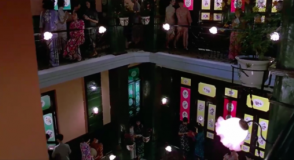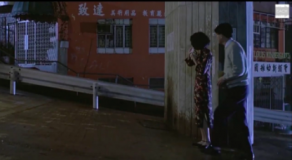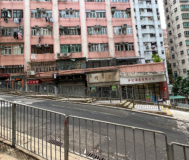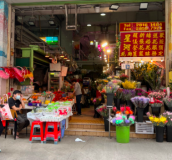ROUGE, DIR. STANLEY KWAN (1988)
Yi Hung Brothel, Shek Tong Tsui, Hong Kong
Stanley Kwan’s ‘Rouge’ (1988) is set in 1930s Shek Tong Tsui, a prevalent red light district at the time. The Yi Hung brothel is the centerpiece. 1 It follows the unrequited love story of a sex worker, Fleur, and a wealthy master, Chan Cheung-Pang. Chan’s family does not approve of their relationship so they commit suicide together to be reunited in the afterlife. However, when Fleur does not meet Chan in the afterlife, she returns to a modern 1987 Shek Tong Tsui looking for her now-aged lover and to realize that he had betrayed her. Fleur and Chan’s relationship is a metaphor for the relationship between traditional and urban Hong Kong, a trope used as a tool throughout the film. During 1980s Hong Kong, ‘Nostalgia Cinema’ was on the rise due to an identity crisis regarding their sovereignty. This is reflected in Rouge’s Chinese renaissance architectural aesthetic, a time when western-trained Chinese architects started working in Hong Kong, combining both the Chinese and Western world. 2
Ghost Fleur arrives at Yi Hung Brothel of Shek Tong Tsui searching for her lover. She is shocked to find that a residential complex stands in the place of the brothel. Prostitution was banned in 1932 in Hong Kong, so most brothels, restaurants and theatres of Hong Kong shut down, completely changing the face of Shek Tong Tsui. 3 Currently a dystopian flyover runs through Shek Tong Tsui while construction noises take over the bustling of this former red-district. Hong Kong, as a place, was ‘prostituted’ spiritually in order to politically and thus architecturally disappear into an ideal East-West city. Such extortion of Hong Kong frames it to be a giant corporate brothel that works under the framework of neoliberal imperialism. However we must also learn that rich history leaves traces, and has certainly reappeared onto Shek Tong Tsui. In the 1930s, Shek Tong Tsui was an infamous flower market. And even now, spot traces of a flower market can be seen in the commercialized municipal building.
Kwan uses the flashback technique in order to perfect the art of ‘Nostalgia Cinema’. Kwan aims to use the cultural story of Hong Kong to allegorically tell the tragic appearance and disappearance of Fleur. Much like old Hong Kong, Fleur disappears in order to stay true to her identity, unwavering by societal expectations. Chan’s betrayal is a symbol for how the relentless processes of modernity prey on the past. When Fleur finally meets a now old and poor Chan she feels betrayal, leaves him a rouge pendant as a souvenir for their love, and turns her back on him. Similar to a bustling local flower market in the middle of a modernized Shek Tong Tsui, the rouge symbolizes Hong Kong’s old memories and serves as nostalgia for modern Hong Kong to reminisce on. Without Hong Kong’s past we can never have arrived so wondrously and brutally at our present, and thus ‘relentless development of a city ‘kills’ its past and ‘buries’ its darkness, yet its past can never be entirely ‘exorcized’’. 4
— Shreeya Lalit Shrimali, 3035842184


Left: Still from Rouge shows 1920s Yi Hung Brothel in its glory. Where Fleur and Chan meet. Right: Still from Rouge shows 1980s place where the brothel was in the film.

This is the same place as the brothel according to my visit to Shek Tong Tsui. The slope is still there; however, the historical places have been taken over by residential buildings


Left: From my visit to Shek Tong Tsui. This market is inside a building named Shek Tong Tsui municipal services building. Right: Still from Rouge shows the blooming market and theater of Shek Tong Tsui in 1920s.
Notes
- Rouge is an adaptation of a novel ‘Rouge’ by Lilian Lee, and is produced by Jackie Chan. The film made 17 million HKD at the box office. Biggest cantopop superstars Anita Mui and Leslie Cheung play Fleur and Chan respectively. The two actors died in 2003 adding much more melancholy to the movie.
- Institute of Historic Building. (2016, August 19). Chinese Renaissance architecture in China and Hong Kong. Chinese renaissance architecture in China and Hong Kong – Designing Buildings. Retrieved March 21, 2022, from https://www.designingbuildings.co.uk/wiki/Chinese_renaissance_architecture_in_China_and_Hong_Kong
- Anon, Laws Which Regulate Sex Work in Hong Kong. Legal information – zi teng. Available at: http://www.ziteng.org.hk/eng/legal-information [Accessed March 21, 2022].
- Ho-Yin Fong, “A Ghost Tour in Rouge’, pg. 97.
— Shreeya Lalit Shrimali, 3035842184
A well-written analysis and reflection on the film as a lens and commentary on Shek Tong Shui’s urban development, particularly at the site around the flyover. You may wish to explain further why you describe it as a “dystopian flyover.” Is this a quotation from a text, the film itself, or your reading of this piece of concrete infrastructure that makes visible not only the development of the district but the broader city’s urban and traffic development in the 1980s? Appreciate your discussion on the allegorical approach of the film and the methods used, particularly the flashbacks and time splicing. Also, what do you observe in the mise-en-scene of the different time periods?